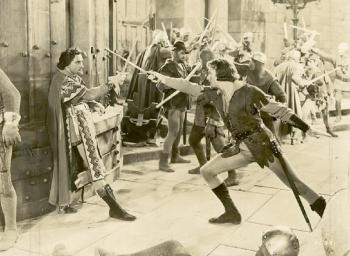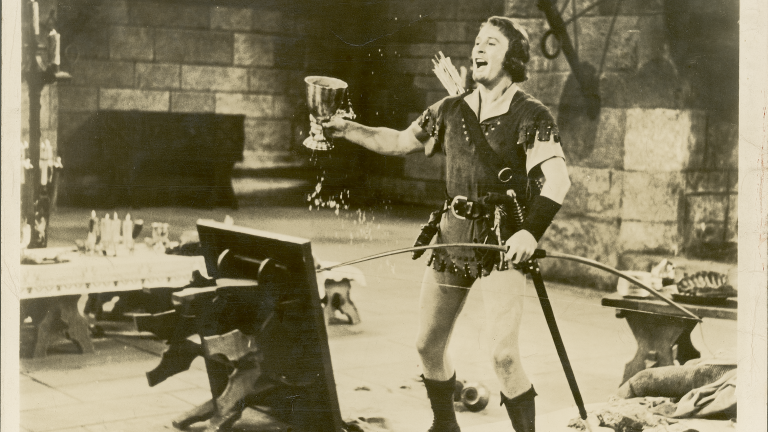

The Adventures of Robin Hood

Ahead of the 80th anniversary of The Adventures of Robin Hood, the NFSA acquired a rare Australian three-sheet poster of the swashbuckling epic released by Warner Brothers on 14 May 1938.
With six earlier film versions, and Douglas Fairbanks' successful portrayal of the legendary outlaw in 1922, it was certainly not the most original material for cinematic interpretation. It was also not new territory for rising Australian star Errol Flynn, who had played heroic swordsmen in Captain Blood (Michael Curtiz, USA, 1935), The Charge of the Light Brigade (Michael Curtiz, USA, 1936) and The Prince and the Pauper (William Keighley, USA, 1937). Despite all this, the studio took a daring leap of faith on the project, employing brand new camera technology in three-strip Technicolor and investing a production budget of over US$2,000,000, making it the most expensive film ever made at the time.
Behind the scenes
Settling on a tried-and-true studio formula, director William Keighley worked with a cast that included ingénue Olivia de Havilland, the distinguished Basil Rathbone, theatre thespian Claude Rains and, of course, the roguish Errol Flynn.

Varied accounts exist on production delays, budget overspends and tepidly received dailies of fight scenes but either way Keighley was soon hauled off the production and replaced by the no-nonsense Hungarian director Michael Curtiz. Contrary to the obvious on-screen success of their collaborations, Curtiz and Flynn did not get along and would frequently be seen violently arguing on set.
According to producer Hal B Wallis, Flynn began to make complaints directly to the producers on all elements of the film's direction, even having his character’s wig completely redesigned mid-production. Whilst it was decided reshoots were not needed due to the original wig mostly being unseen beneath his hat, a still in the NFSA’s collection might be a glimpse at the original character conception (see image at left).

Flynn was known to occasionally clash with his co-stars, including long-time friend Basil Rathbone in his villainous role as Sir Guy of Gisbourne. In a 1969 interview Rathbone, a skilled and professionally trained fencer said, ‘The only actor I actually fought with on the screen was Flynn, and that's the only time I was really scared. I wasn't scared because he was careless but because he didn't know how to protect himself.' In later years Rathbone would laughingly commiserate about his ability to make Flynn look better in choreographed fight scenes.
A rising star
Hal B Wallis and Henry Blanke utilised the 28-year-old Flynn’s natural athleticism and good looks to promote the film. The Warner Brothers publicity machine was so successful in the promotion of its leading man that Flynn was later voted the world’s 4th biggest star by industry magazine Variety. Despite this, or perhaps as an attempt to play into the increasingly loud whispers of gossip columnists, a number of scenes and publicity stills from Robin Hood hint at Flynn’s increasingly excessive habits and poor behaviour on and off the set. These stills included Flynn sloshing an oversized goblet of alcohol, upturning tables in a banquet hall, standing suggestively with legs spread in tights, menacingly facing off with co-stars and clutching at his leading lady (see photo gallery, below).

Errol Flynn brandishes an oversized wine goblet in The Adventures of Robin Hood, 1938. NFSA title: 1516596.
Click on image to view.

Errol Flynn and Olivia de Havilland embrace in The Adventures of Robin Hood, 1938. NFSA title: 1516443.
Click in image to view.

Errol Flynn in tights with sword drawn in The Adventures of Robin Hood, 1938. NFSA title: 1516428.
Click on image to view.

Errol Flynn glares at Basil Rathbone in The Adventures of Robin Hood, 1938. NFSA title: 1516647.
Click on image to view.

Errol Flynn upturns a table in a banqueting hall in The Adventures of Robin Hood, 1938. NFSA title: 1516463.
Click on image to view.
Flynn, de Havilland and box-office success
As Robin Hood, Flynn had again been paired with 21-year-old Olivia de Havilland in an apparent effort to recreate the successful formula of their previous films together.

Later Flynn admitted to ‘bothering’ de Havilland with his ‘teasing ways’. He wrote, ‘... she told me she lived in terror of what bit of idiocy I’d spring next’. In a 2009 interview, the 92-year-old De Havilland graciously recalled, ‘In his autobiography … he wrote about falling in love with me … I have not talked about it a great deal but the relationship was not consummated. Chemistry was there though. It was there.' Flynn and de Havilland would go on to co-star in nine feature films together.

Despite the now legendary fractious on-set relations, The Adventures of Robin Hood was a resounding success with audiences and critics and won three Academy Awards. But in his autobiography, My Wicked, Wicked Ways (1959), Flynn recalled the production as a ‘... super costly film ... another Jack Warner gamble ... there were great expectations for it around the studio. But I was tired. The hard work, the round of social life in Hollywood, my trying personal life with Lili [Damita, actress and then wife of three years], this was all a drain.'
A sequel was proposed to capitalise on the film's success but the follow-up, to be titled Sir Robin of Locksley, was never developed.
The NFSA recently acquired a rare Australian three-sheet poster of The Adventures of Robin Hood. Unusually sized at roughly 2 x 1 metres and in immaculate condition, the poster vividly captures all the film’s technicolour glory and iconic imagery that remain just as striking today, exactly 80 years after its original release on 14 May 1938.
The National Film and Sound Archive of Australia acknowledges Australia’s Aboriginal and Torres Strait Islander peoples as the Traditional Custodians of the land on which we work and live and gives respect to their Elders both past and present.


